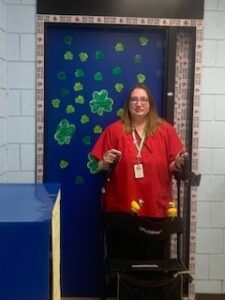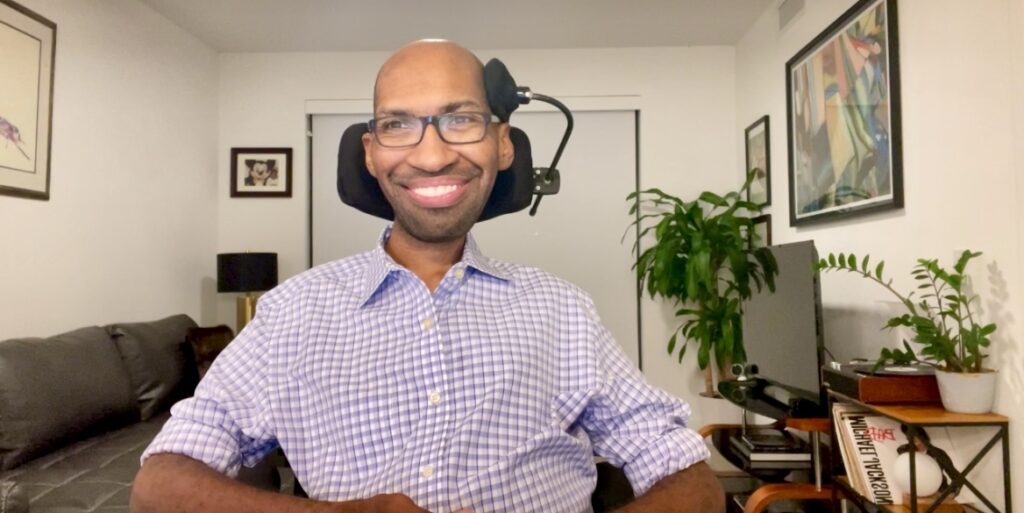
Quest for Success: Nicole Lahoud
By Rebecca Hume | Monday, February 28, 2022
5 Second Summary
Quest for Success explores the different paths that individuals with neuromuscular disease have taken to reach their potential and pursue dreams. This series spotlights individuals from our community and shares their journey to independence and accomplishment.
Success looks different to everyone and this monthly blog will detail the different paths that individuals with neuromuscular disease have taken to reach their potential and the steps they took to get where they are today. Each month we will spotlight one individual from our community and share his or her journey to independence and accomplishment. We hope that these stories empower and inspire our readers to unlock the possibilities in their own lives…because the possibilities are limitless.
High School Teacher Demonstrates How to Excel Beyond Barriers
Nicole Lahoud knows the importance of advocating for yourself, making accommodations, and promoting confidence in the educational setting. The 49-year-old high school teacher offers unique insight into the value of structuring a classroom to meet the needs of everyone.
Nicole lives with fascioscapulohumeral muscular dystrophy (FSHD), a neuromuscular disease that primarily impacts the muscles of the face, shoulders, and upper arms. She is also diagnosed with psoriatic arthritis. Both diagnoses impact her mobility and stamina. Nicole has not allowed these limitations to deter her from continuing her own education, earning a master’s degree in special education, and continuing to commit to the education of students with disabilities. Her classroom and teaching style exemplify the important truth that you can do anything that you set your mind to – whether you have a disability or not.
Early life and late diagnosis
Although born with FSHD, Nicole was not diagnosed until she was a young adult. As a child, she was not able to raise her arms the way other children could and would sometimes tire faster than her peers. But it wasn’t until her early twenties that she recognized that the variation in her abilities was indicative of a neuromuscular disease.
At one of her first jobs after college, Nicole and her colleagues were discussing classroom accommodations for a preschool student with cerebral palsy who was not able to raise his hand in class. When Nicole pointed out that she also could not raise her arms, a colleague suggested that she meet with the school physical therapist. That therapist suggested that Nicole might have a type of muscular dystrophy and wrote down the name and address of an MDA Care Center
Nicole advocated for a referral from her primary care physician, who was hesitant to pursue a diagnosis. Her doctor did not think that she had symptoms consistent with muscular dystrophy. In fact, her doctor suggested laziness as the origin of Nicole’s symptoms. Nicole refused to accept this misdirected prognosis. She could recognize that her muscles were getting weaker with time and that her mobility limitations were not within her control. She insisted that the doctor write a referral for her. Her persistence was imperative to finally understanding her body a little better. She met with an MDA Care Center neurologist, who was able to assess her physical symptoms and order DNA testing that detects abnormalities on the 4th chromosome. Nicole was diagnosed with FSHD.
Persisting through progression
At the time of her diagnosis, Nicole had already obtained her bachelor’s degree in special education from St. Joseph College. Ever since an interaction with a student who had a disability in her kindergarten class, Nicole had known that she wanted to be a teacher and that she wanted to work with children with disabilities. Pursuing that dream was one of her top priorities, second only to being the best mother to her children. Her diagnosis would not derail her quest for success.
While the progression of her disease began presenting challenges, Nicole did not allow them to hinder the progression of her own education. She completed her master’s degree online at Grand Canyon University while raising two children at home. When one of her children was diagnosed with autism, Nicole became even more driven to excel in a field that would allow every student to thrive.
To pay for college and graduate school, Nicole applied for educational loans, financial assistance, grants, and scholarships. She sought loans and financial support through the Federal Student Aid (FAFSA) program. Quick to share her tricks of the trade, Nicole notes that applying for FAFSA as early as possible is one of the most important things that a college-bound student can do. The due date for a FAFSA application is October 1st of every year; by applying early students have the opportunity to receive more money. Nicole also obtained grants and scholarships, including the TEACH grant, a grant that helped pay for her master’s degree contingent upon her fulfillment of teaching for four years in a Title 1 school district.

Nicole Lahoud at the Big E Fair in Massachusetts.
Nicole teaches full-time at a high school in Waterbury, CT. She teaches her students to advocate for themselves and motivates them to never give up – even if they want to. Nicole shares that there were times that she wanted to give up on teaching full time as her physical symptoms added new challenges, but her commitment to her children kept her motivated. Nicole said, “If it wasn’t for my kids, I probably would have thrown in the towel…but I want what’s best for my kids and as the mother of a special needs child, I want them to know that they can do everything that they want to do and be independent.”
Educating with accommodations
When she interviewed for her current position, her FSHD symptoms were not as prominent as they are now. Nicole was able to navigate the interview process, and her subsequent teaching role, by overcompensating for her areas of weakness. She was intentionally over-enthusiastic to counter the limiting impact that facial weakness had on her smile. She squeezed as hard as she could when shaking hands to disguise weakness in her extremities. She did not disclose her disability, a choice partially based in fear that it might impact hiring decisions.
The first time that she voiced the need for an accommodation was when the school was installing new dry erase boards and she requested to have hers installed lower because she could not lift her arms higher. Shortly after that request, she shared her diagnosis with the principal because she was concerned that her need to yawn frequently (a means to better breathing) would be misinterpreted as disrespect or disinterest. Her informal disclosure was met with kindness and understanding.
It wasn’t until her first real request for an accommodation, having her classroom moved to the first floor, that Nicole experienced frustration with the administration. The administration at that time concluded that a key to the elevator was an adequate accommodation to accessing her second-floor classroom. This proved insufficient as the elevator was often out of service.
Nicole advocated for her needs just as she advocates for the needs of her students. She requested a letter from her neurologist and formally disclosed her diagnoses. She also enlisted the help of her union lawyer and union president. Though an arduous process, she was successful in her endeavors and her classroom was moved to the first floor.
Nicole made a point to share that the current administration is eager to meet any new needs that arise. When she requested an additional laptop for remote teaching because she did not have the muscle strength to carry one to and from school, they provided one immediately. When there was an issue with snow removal on the ramp to enter the school, the principal quickly addressed and rectified the problem.
Staying independent
Outside of work, Nicole relies on a few accommodations at home. She has a daughter in college and a teenage son at home with her, both of whom are always willing to help their mom. She also lives with a close friend who provides consistent, informal home support in exchange for rent. Nicole requires assistance with cooking and cleaning due to the limited range of motion in her arms. She is not able to carry heavy objects, so her friend helps to carry laundry and shopping bags. Although her symptoms and general fatigue vary in intensity from day to day, Nicole finds balance in doing small chores independently – often vacuuming for 10 minutes or folding laundry while sitting.
Nicole has also found support in a few avenues outside of home and work. She drives to school every day but recently started experiencing more difficulty putting her seatbelt on and switching gears. She is in the process of having her vehicle modified for accessibility and, because she uses her vehicle for work, she was able to connect with her state’s Vocational Rehabilitation Agency for financial assistance.
We were thrilled to hear that Nicole credits MDA’s Quest magazine articles and advertisements as a valuable resource that has helped her to navigate her disease. Nicole also recognizes the importance of finding the right doctor and continuing to advocate for appropriate care. She says, “If you find the right doctor, he or she can be a godsend. But even then, you have to kind of fight your way. Advocate for yourself.”
Promoting positivity and awareness
Advocating for yourself, believing that you can do anything that you put your mind to, stepping out of your comfort zone, and always finding a reason to laugh are the key lessons that Nicole imparts in her classroom. She also uses her disability as an opportunity to educate and raise awareness.
Nicole wears leg braces, hand braces, and wrist braces every day, and often uses a walker. She prides herself on being very open with her students when sharing the details of her disease and its progression. By creating an open dialogue with her students, she demonstrates that a disability does not need to be something that you are ashamed of, and it does not need to hinder you from achieving your goals.

Nicole Lahoud in front of her MDA Shamrock decorated classroom door.
“I tell my students… they have different disabilities, and they have to find ways to use them for their success. Mine is to spread awareness.”
In fact, if you walk into Nicole’s classroom at any time throughout the year, you will see MDA Shamrocks pinned to her door. Nicole writes a different neuromuscular disease on each shamrock and leaves them up year-round to show her students how many different forms of muscular dystrophy there are – and to teach them about each one.
The relationship that Nicole has developed with her students is her favorite thing about teaching. She loves creating a safe and accepting environment that allows her students to open up, gain confidence, and grow. And she also loves teaching her students the importance of keeping a sense of humor and choosing happiness – whether this means playing corny songs to make her class laugh or reminding her students to find joy in the little things. Lessons, laughter, and confidence that they can carry with them for the rest of their lives.
Nicole’s lasting impact on her students is exemplified by her continued relationships with former students. One of her students, who graduated years ago, continued to reach out to Nicole for guidance throughout his time at Naugatuck Community College and as he transitioned into the workforce. From offering tutelage for his college math classes to providing advice and discussion regarding appropriate behaviors required to maintain employment, Nicole’s impact on this young man’s future is undeniable. Before moving out of state, he often returned to visit her classroom to speak to her current students about the importance of learning and pursuing goals. An importance that Nicole continues to instill in her students year after year as they embark on their own quests for success.
TAGS: College, Education, Employment, Healthcare, Parenting, Personal Care Attendants, Quest for Success, Resources, Year of Independence
TYPE: Blog Post
Disclaimer: No content on this site should ever be used as a substitute for direct medical advice from your doctor or other qualified clinician.




